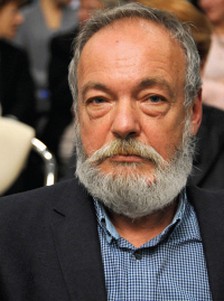
Srđan Hofman (1944, Serbia) acquired his undergraduate degree in composition at the Music Academy in Belgrade (today’s Faculty of Music) in 1968 under the supervision of Stanojlo Rajičić and then also an MA degree in the same class in 1972. Also, he spent two relatively brief periods pursuing further studies abroad. He remains active today as a professor emeritus of composition at the Faculty of Music and multimedia art at the University of Arts in Belgrade, as well as the founder and director of the Faculty’s Sound Studio. He also produces scholarly work in music theory related to issues in contemporary music and has authored a large number of studies published in scholarly journals, as well as the book Osobensti elektronske muzike (Particularities of Electronic Music).
Hofman’s oeuvre comprises numerous orchestral, vocal-instrumental, chamber, electro-acoustic, solo, and choral works. He has won many awards, including two first awards of the Composers’ Forum for his works Koncertantna muzika (Musica concertante, 1994) and Znakovi (Signs, 1995), the Stevan Mokranjac Award for Gledajući u ogledala Aniša Kapura (Looking at the Mirrors of Anish Kapoor, 2011), Composer of the Year Award for Ogledalo (Mirror, 2012), the Composers’ Association of Serbia Award, and the Great Plaque of the University of Arts in Belgrade.
The piece Through Boxes of Sound 2 for piano and electronics was written in 2016 as a sequel to the work Through Boxes of Sound 1 for clarinet, violin, and piano. The pieces may also be performed in sequence, as a diptych fastened together at the ending of the first ‘movement’, which is also the beginning of the second.
My understanding of a box is a clearly delineated (and thereby defined) closed space, used for storing documents, notes, photographs, items… related to a certain purpose or use, or to a given person, event, time period… By contrast, sound travels freely and unpredictably and if it can be ‘captured’ at all, classified, and stored into an ‘allocated’ box of its own, that means it features a characteristic, recognisable singularity that suggests a certain genre or stylistic manner.
The piece Through Boxes of Sound 2 (as well as the diptych, of which it is the second part) is built upon several simple motives, which, in their unpredictable, seemingly asynchronous unfolding, occasionally ‘fall’ into boxes comprising various, discreetly suggested musical stereotypes. The work’s sonic content is realised ‘on the spot’, by combining the processing of sounds produced on an acoustic piano, prepared electronic sequences, and direct ‘playing’ on the computer by using a MIDI keyboard.


